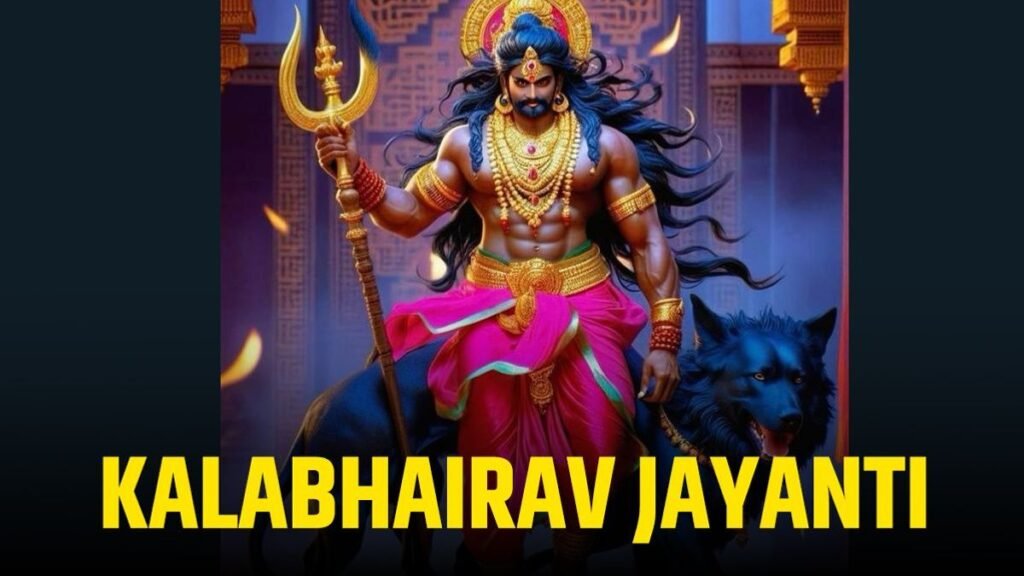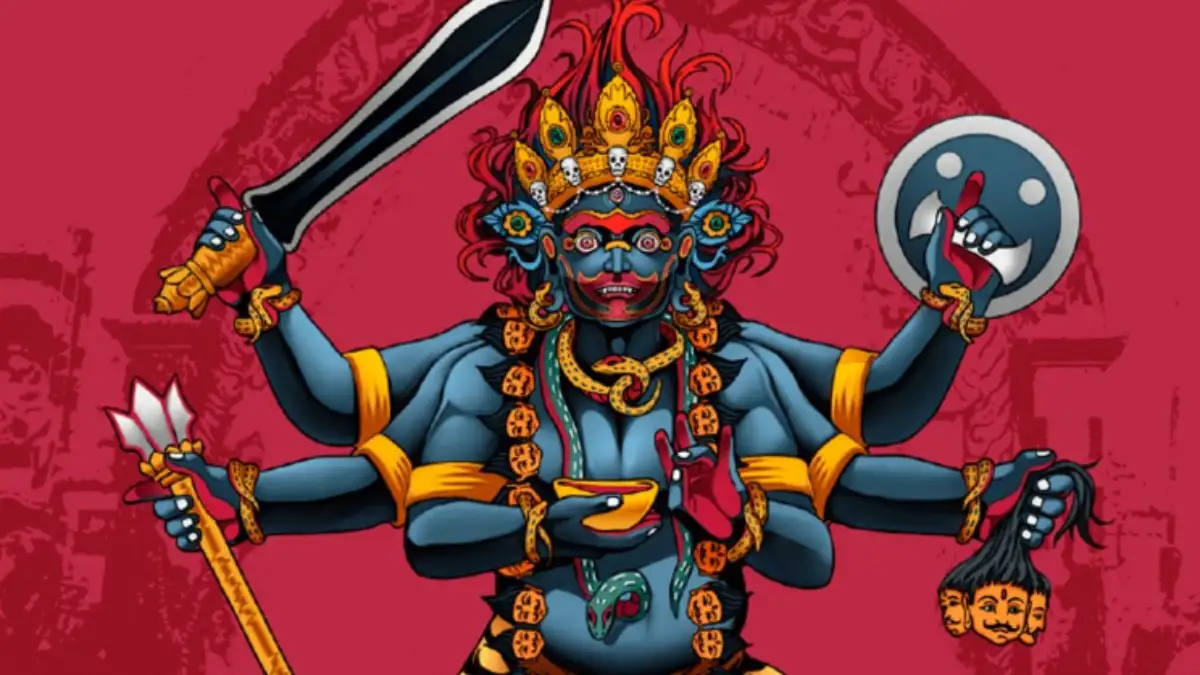Every year, devotees across India observe Kalabhairav Jayanti (also known as Bhairava Ashtami or Kalashtami 2025 when referencing the upcoming year). On this auspicious day, devotees remember and worship Lord Kalabhairav — the fierce manifestation of Lord Shiva as the guardian of time and death. This article explores the deep Significance of Kalabhairav Jayanti, the rituals of the Kalabhairava Puja Vidhi, the power of the Kalabhairava Mantra, and why visiting major Bhairava Temples in India adds meaning to your devotion.
Who is Lord Kalabhairav?
Lord Kalabhairav (sometimes spelled Kalabhairava) emerges in Hindu tradition as a fearsome yet compassionate figure—an avatar of Lord Shiva entrusted with time (kāla) and cosmic justice. The name “Kala-Bhairav” literally means “the terrifying one of time.” His role is dual: he destroys ignorance, fear, and ego, while protecting his devotees and upholding dharma.
In Hindu lore, Kalabhairav appears when Brahma’s arrogance reached a peak; to humble him, Shiva created Kalabhairav who severed Brahma’s fifth head, reminding creation that ego must yield to truth.
He is especially revered as the Kotwāl (chief guardian) of Kashi (Varanasi) — thus the title “Lord of Kashi.” Worshipping him is believed to protect devotees from untimely death, negative influences, and guide them toward spiritual maturity.
Significance of Kalabhairav Jayanti
Timing & Names
Kalabhairav Jayanti falls on the Ashtami (eighth lunar day) of the Krishna Paksha (waning moon) in the month of Margashirsha (in northern India) or Kartika (in southern traditions).
In 2025, this occurs on 11–12 November (Ashtami begins late on 11 Nov, ends on 12 Nov) according to most Panchangs.
The festival is also referred to as Bhairava Jayanti or Bhairava Ashtami.
Why this day matters
- On this day, the manifestation of Lord Kalabhairav is honoured. The divine emergence marks the triumph of time, truth, and fearlessness.
- Worshipping him is believed to remove fear, protect from accidents or sudden misfortune, and cleanse past karmas and negative influences.
- This festival emphasizes the nature of time itself—how life, death, and transition are interconnected—and invites devotees to be disciplined, humble, fearless, and oriented toward spiritual progress.
- For the city of Kashi, he is the presiding guardian, and realizing his protection is vital for spiritual aspiration in Varanasi and beyond.
Kalabhairava Puja Vidhi (How to Worship)
The proper ritual of Kalabhairava Worship Rituals can bring deep spiritual benefit when done with sincerity. Below is a guided overview of the Puja Vidhi.
Preparatory Steps
- Wake up early, take a clean bath before sunrise. Purify the body and mind.
- Clean your puja space, arrange an image or murti of Lord Kalabhairav, and gather offerings such as black sesame seeds (til), mustard oil, oil lamps, incense, flowers, and fruits.
- Many devotees observe a fast (vrat) on this day—either full-day or partial—offering their discipline to the deity.
Main Rituals
- Light an oil lamp (preferably four-faced diya or a multi-wick lamp) facing the deity, offering illumination to dispel darkness of ignorance.
- Offer items: black sesame, mustard oil, flowers, fruits, sweets (preferably halwa, poori) and optionally feed dogs (considered his vahana or vehicle).
- Recite the Kalabhairava Mantra, for example:
“Om Kaala Bhairavaya Namah.” - Perform aarti in the evening or at midnight — the Nishita Kaal hour is considered highly potent.
- After the puja, distribute prasad among family, friends, and the needy; perform charity, especially feeding animals or dogs, aligning with the compassionate nature of the deity.
What to Avoid & Focus On
- Avoid arrogance, unnecessary arguments, harsh words, or negative thoughts. The day emphasizes humility and surrender.
- Keep the mind calm, maintain devotion, and focus on inner purification rather than just outward ritual.
Kalabhairava Mantra & Its Power

The Kalabhairava Mantra is a sacred set of sounds connecting the devotee with the divine energy of Lord Kalabhairav.
One of the simplest forms is:
Om Kalabhairavaya Namah.
Chanting this mantra with faith on Kalabhairav Jayanti is believed to:
- Remove fear, darkness, and confusion from one’s life.
- Help one gain mastery over time, mind, and destiny (since “Kaal” means time).
- Create inner strength, focus, and commitment toward truth and spiritual growth.
It’s best to recite the mantra multiple times (for example, 27 or 108 times) during the ritual, ideally at midnight or while meditating.
Visiting Bhairava Temples in India
There are many sacred temples dedicated to Lord Kalabhairav and his various forms; these become focal points for devotees on this festival day. Visiting such temples adds richness to the festival observance.
Highlights
- Varanasi (Kashi), Uttar Pradesh: The Kalabhairav Temple in Varanasi is one of the most important. As the guardian of the city, Lord Kalabhairav’s worship there holds special significance.
- Ujjain, Madhya Pradesh: Known for Kalabhairav worship in connection with the Mahakaleshwar Temple complex. Large gatherings and special pujas happen here on Bhairav Jayanti.
- Other famous Bhairava Temples in India — including those in Tamil Nadu, Gujarat, and Rajasthan — also witness special celebrations and aartis during this sacred time.
Attending the puja in a temple helps the devotee feel collective spiritual energy, witness proper ritual forms, and share the blessings with a larger community.
Why Worship Lord Kalabhairav?
Worshipping Lord Kalabhairav on his Jayanti is not just an external ritual—it holds deep internal significance.
- Fearlessness & Protection: As the destroyer of fear and negative forces, his worship empowers the devotee to face life’s challenges.
- Time & Discipline: Lord Kalabhairav as “Kaal” reminds us that time is precious and life is transient. Worship encourages living with awareness and discipline.
- Karmic Cleansing: Devotees believe that sincere worship reduces past karmic burdens and opens the path for spiritual growth.
- Support for Devotees: He is the guardian of sacred spaces and protector of seekers moving toward truth.
- Connection with Lord Shiva Avatars: Lord Kalabhairav is one of the powerful Lord Shiva Avatars, showing how Shiva manifests in intense forms to protect dharma. Worship strengthens one’s connection to the larger cosmic order.
Tips To Make the Day Special
- Begin early in the day with purity of mind and devotion.
- Keep distractions away from your puja space—phones off, mind calm.
- Choose a quiet moment (if possible, at midnight) to meditate on Lord Kalabhairav’s form: fearless, timeless, just.
- Feed stray dogs or animals as an act of service in his name — this connects with his symbol as the dog-vahana.
- Share the prasad with others—giving multiplies the blessing.
- After the ritual, reflect on how you can live with more time-awareness, less procrastination, and more fearlessness.
- Dress simply and respectfully—dark or black clothing is often associated with Bhairava worship.
Closing Thoughts
The festival of Kalabhairav Jayanti is more than a ritual observance—it is an invitation to face the deepest truths: time, death, discipline, and the fearless pursuit of truth.
By worshipping Lord Kalabhairav with sincerity, following the Kalabhairava Puja Vidhi, chanting the Kalabhairava Mantra, visiting sacred Bhairava Temples in India, and performing acts of service, devotees align with a transformative force.
FAQ
Q1. When is Kalabhairav Jayanti in 2025?
Kalabhairav Jayanti, also known as Bhairava Ashtami or Kalashtami 2025, will be observed on 11–12 November 2025.
Q2. Who is Lord Kalabhairav?
Lord Kalabhairav is a fierce form of Lord Shiva, known as the guardian of time and the protector of Kashi.
Q3. What is the significance of Kalabhairav Jayanti?
The day marks the appearance of Lord Kalabhairav, symbolizing fearlessness, discipline, and victory over negativity.
Q4. How is Kalabhairav Jayanti celebrated?
Devotees perform Kalabhairava Puja Vidhi, chant the Kalabhairava Mantra, observe fasts, and visit Bhairava Temples in India.
Q5. What are the benefits of worshipping Lord Kalabhairav?
His worship removes fear, grants protection, purifies karma, and blesses devotees with courage and time-awareness.
Q6. Which are the famous Bhairava temples in India?
Prominent temples include those in Varanasi (Kashi) and Ujjain, where grand celebrations take place during Bhairav Jayanti.
Q7. Is Kalabhairav an avatar of Lord Shiva?
Yes. Lord Kalabhairav is one of the powerful Lord Shiva Avatars, representing time, justice, and divine protection.
Krishna Mishra writes for Insights of Hinduism, where he shares heartfelt thoughts on festivals, traditions, and the timeless wisdom of Sanatan Dharma. His aim is to keep the essence of Hindu culture alive in a way that feels simple, authentic, and relatable to everyone.


